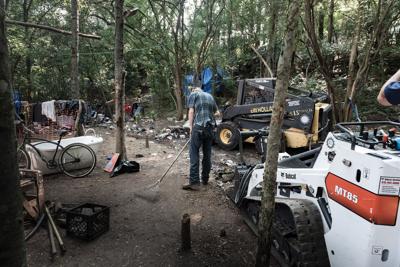Before the Metro Office of Homeless Services’ weekly care coordination meeting, social workers tasked with getting Nashville’s homeless population a place to live receive an email that tells them what is up for grabs that week. It could be a temporary shelter space, a bed at a mobile housing navigation center, a Section 8 voucher or an Urban Housing Solutions unit. The list of available resources varies each week, but it typically includes a handful from each category. Sometimes, however, there’s nothing on the table.
There are meetings specifically for veterans, families and youth as well, but an additional meeting has been introduced solely for encampments. It’s part of a national trend — the U.S. Supreme Court is set to hear a case next week that could allow states to outlaw camping on public property after one such law was blocked in a circuit court, citing the Eighth Amendment’s ban on cruel and unusual punishment. Tennessee has one of the country’s most punitive camping laws — which makes unauthorized camping on all public property a felony — but it has gone mostly unenforced.
When a housing resource comes available, the social workers check their collaborative list, also known as a priority pool. At the top are unhoused individuals deemed most vulnerable, according to the Vulnerability Index-Service Prioritization Decision Assistance Tool (VI-SPDAT). It’s a part of the coordinated entry process, which became a requirement for those receiving funding from the U.S. Department of Housing and Urban Development in 2017. The idea is that services should not be handed out on a first-come, first-serve basis, but instead go to those who need them most.
Nashville’s homeless service providers gather and decide who gets resources — a handful of resources for a list of 3,800 people. That’s an undercount, too. The latest point-in-time count — in which service providers count all of those in shelters and sleeping outside on one night in January — found that only half of those counted were already in the database. That’s according to an estimate by India Pungarcher, an outreach worker for the nonprofit Open Table Nashville.
Pungarcher or a team member always attends the care coordination meetings. It’s a chance to go to bat for her clients and give updates on any changes since they filed their assessment.
Open Table Nashville calls for housing options instead of laws that punish unhoused people for sleeping outdoors
“A lot of times it’s just really helpful to be on those calls if you have a friend’s name that is higher up on the priority pool, so that you can advocate for them and try to get them a referral as soon as possible,” Pungarcher says.
The VI-SPDAT system is something that homeless service providers have had qualms about for years. It asks about the individual’s history of housing and homelessness, risks (mainly of crime committed against them), socialization and daily functioning and wellness. It’s known to be biased toward white respondents, who are more likely to disclose the information and therefore are bumped up the list.
April Calvin, executive director of Metro’s Office of Homeless Services, says the office is working with HUD to introduce a new vulnerability tool, but does not disclose a timeline.
“I think just the style or the form of questions sometimes can cause people to not feel like they can be their authentic selves,” Calvin says. “I think that sometimes it’s geared toward more of one race than another race, so I’m definitely hoping that it will correct that.”
There’s tension around encampments and the VI-SPDAT. If one camp is chosen to be closed, those living there are assigned resources not based on their VI-SPDAT score, but based on where they live. Some resources are offered at the encampment meetings on Monday, and others are offered on Thursday at the individual meeting. Pungarcher notes that sometimes there are no options left by the time Thursday rolls around.
“In those care coordination meetings with folks from camps, we’re not even talking about VI-SPDAT scores,” Pungarcher says. “It’s just everyone in the camp is at some point going to get referred to something.”
Calvin insists the encampment calls do not affect what’s available, though there is substantial overlap between the demographics of the people discussed on the two care coordination calls.
“Those two can really be added into one, but I know people have wanted to have a very focused interest on what’s going on with the people in the encampment, and that’s the only reason that that care coordination call exists separate from individuals,” Calvin says. “That encampment conversation doesn’t take away from resources or opportunities or even conversations around people that are experiencing homelessness that weren’t a part of that encampment closure.”






